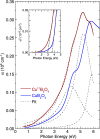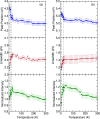Anomalous boron isotope effects on electronic structure and lattice dynamics of CuB2O4
- PMID: 35516545
- PMCID: PMC9057853
- DOI: 10.1039/d0ra08200g
Anomalous boron isotope effects on electronic structure and lattice dynamics of CuB2O4
Abstract
Copper metaborate had a unique crystal structure and exhibited noteworthy magnetic phase transitions at 21 and 10 K. The electronic structure and lattice dynamics of copper metaborate Cu11B2O4 single crystals were investigated and compared with the optical properties of CuB2O4, to assess the boron isotope effect. The optical absorption spectrum at room temperature revealed two charge-transfer bands at approximately 4.30 and 5.21 eV with an extrapolated direct optical band gap of 3.16 ± 0.07 eV. Compared with the data on CuB2O4, the electronic transitions were shifted to lower energies upon the replacement of a heavier boron isotope. The band gap was also determined to be lower in Cu11B2O4. Anomalies in the temperature dependence of the optical band gap were observed below 21 K. Furthermore, 38 Raman-active phonon modes were identified in the room-temperature Raman scattering spectrum of Cu11B2O4, which were also observed in CuB2O4 with a shift to lower frequencies. No broadening caused by isotopic changes was observed. As the temperature decreased, phonon frequencies shifted to higher wavenumbers and the linewidth decreased. Anomalous softening in the Raman peaks below 21 K was also revealed.
This journal is © The Royal Society of Chemistry.
Conflict of interest statement
The authors declare no competing interests.
Figures








Similar articles
-
Electronic structure and lattice dynamics of Ba2CuTeO6 single crystals.RSC Adv. 2020 May 27;10(34):20067-20072. doi: 10.1039/d0ra02314k. eCollection 2020 May 26. RSC Adv. 2020. PMID: 35520444 Free PMC article.
-
Optical Studies on the Phase Transitions in YBaMn2O6 Single Crystals.ACS Omega. 2021 Aug 23;6(34):22137-22150. doi: 10.1021/acsomega.1c02763. eCollection 2021 Aug 31. ACS Omega. 2021. PMID: 34497905 Free PMC article.
-
Optical Study of the Electronic Structure and Lattice Dynamics of NdBaMn2O6 Single Crystals.Sci Rep. 2019 Dec 3;9(1):18164. doi: 10.1038/s41598-019-54524-0. Sci Rep. 2019. PMID: 31796772 Free PMC article.
-
Temperature-dependent optical properties of CuFeO2 through the structural phase transition.RSC Adv. 2021 Dec 17;11(63):40173-40181. doi: 10.1039/d1ra08096b. eCollection 2021 Dec 13. RSC Adv. 2021. PMID: 35494107 Free PMC article.
-
Phase Transitions in Boron Carbide.Materials (Basel). 2023 Oct 17;16(20):6734. doi: 10.3390/ma16206734. Materials (Basel). 2023. PMID: 37895716 Free PMC article. Review.
References
-
- Haller E. E. Isotopically engineered semiconductors. J. Appl. Phys. 1995;77:2857–2878. doi: 10.1063/1.358700. - DOI
-
- Mulliken R. S. The isotope effect in band spectra, part I. Phys. Rev. 1925;25:119–138. doi: 10.1103/PhysRev.25.119. - DOI
-
- Bardeen J. Cooper L. N. Schrieffer J. R. Theory of superconductivity. Phys. Rev. 1957;108:1175. doi: 10.1103/PhysRev.108.1175. - DOI
LinkOut - more resources
Full Text Sources
Research Materials
Miscellaneous

